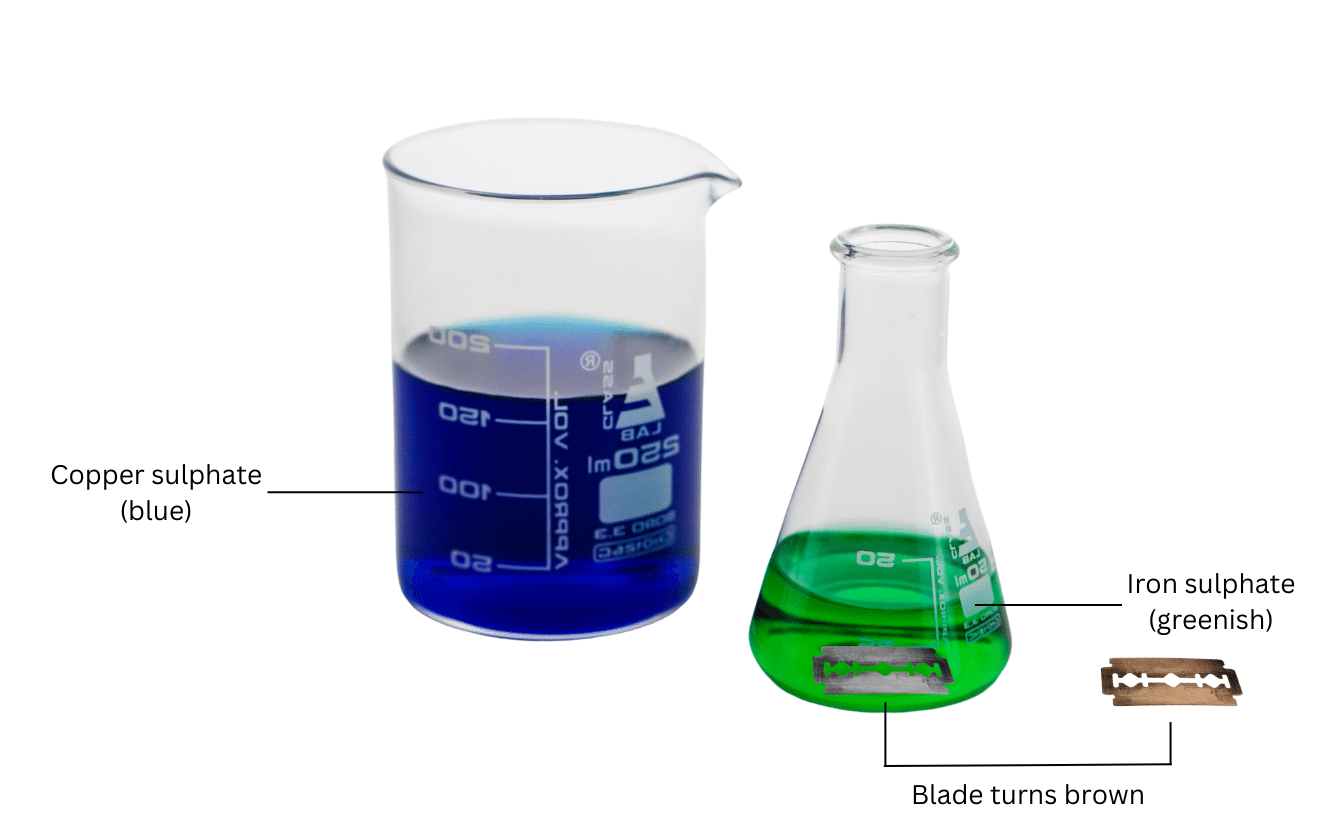7. Complete Activity 5.7 (Page 50). (To be demonstrated by the teacher) Dissolve about a teaspoonful of copper sulphate (blue vitriol or neela thotha) in about half a cup of water in a glass tumbler or a beaker. Add a few drops of dilute sulphuric acid to the solution. You should get a blue coloured solution. Save a small sample of the solution in a test tube or a small glass bottle. Drop a nail or a used shaving blade into the remaining solution. Wait for half an hour or so. Observe the colour of the solution. Compare it with the colour of the sample solution saved separately (Fig. 5.4). Do you see any change in the colour of the solution? Take out the nail or the blade. Has it changed in any way?
Answer:
The above activity can be carried out as follows:
Aim: To observe what happens when you add a nail to the copper sulphate solution and make the necessary conclusions based on the observations.
Materials Required: Copper sulphate, cup, water, two beakers, dilute sulphuric acid, blade.
Procedure:
(i) Dissolve a teaspoonful of copper sulphate (blue vitriol) solution in about half a cup of water in a beaker.
(ii) Add a few drops of dilute sulphuric acid to the solution.
(iii) Save a sample of the solution in a beaker and drop a nail into the remaining solution. Wait for half an hour or so and observe what happens.
(iv) Take out the blade and observe if it has changed in any way.
Observations:
You will observe that:
- The colour of the solution turns from blue to green on addition of the nail.
- There is a brown deposit on the blade.

Conclusions:
We conclude that:
- Copper sulphate reacted with iron to form iron sulphate, a new substance. This changed the colour of the solution turned from blue to green. The reaction is shown below:
Copper sulphate solution (blue) + Iron → Iron sulphate solution (green) + Copper (brown deposit)
- The brown deposit on iron is copper formed due to the reaction, another new substance.
- Two new substances are formed with new properties. Hence, this is a chemical change.
“Complete Activity 5.7 (Page 50). (To be demonstrated by the teacher) Dissolve about a teaspoonful of copper sulphate (blue vitriol or neela thotha) in about half a cup of water in a glass tumbler or a beaker. Add a few drops of dilute sulphuric acid to the solution. You should get a blue coloured solution. Save a small sample of the solution in a test tube or a small glass bottle. Drop a nail or a used shaving blade into the remaining solution. Wait for half an hour or so. Observe the colour of the solution. Compare it with the colour of the sample solution saved separately (Fig. 5.4). Do you see any change in the colour of the solution? Take out the nail or the blade. Has it changed in any way?” – Solved.
Related Links:
Solution to Extended Learning – Activities and Projects Question 1
Solution to Extended Learning – Activities and Projects Question 2
Solution to Extended Learning – Activities and Projects Question 3
Solution to Extended Learning – Activities and Projects Question 4
Solution to Activity 5.1
Solution to Activity 5.2
Solution to Activity 5.3
Solution to Activity 5.4
Solution to Activity 5.5
Solution to Activity 5.6
Solution to Activity 5.8
Solutions to Chapter 5 Physical and Chemical Changes


